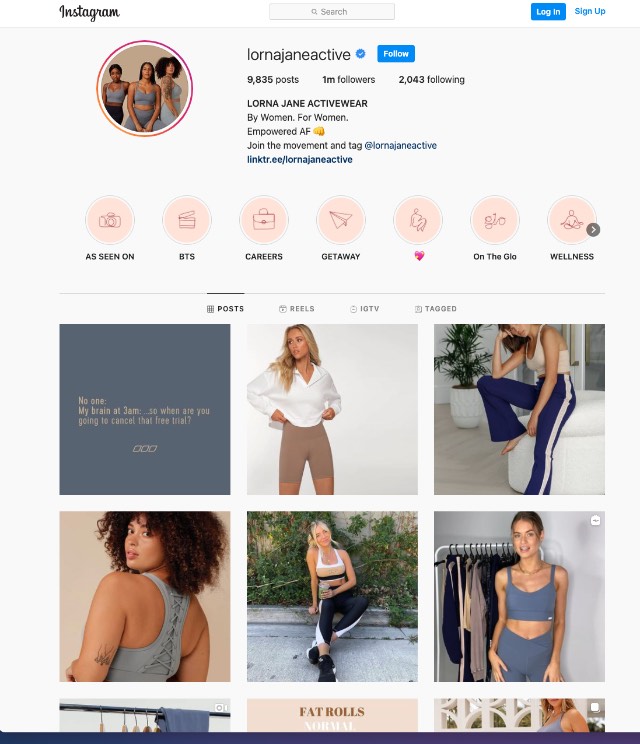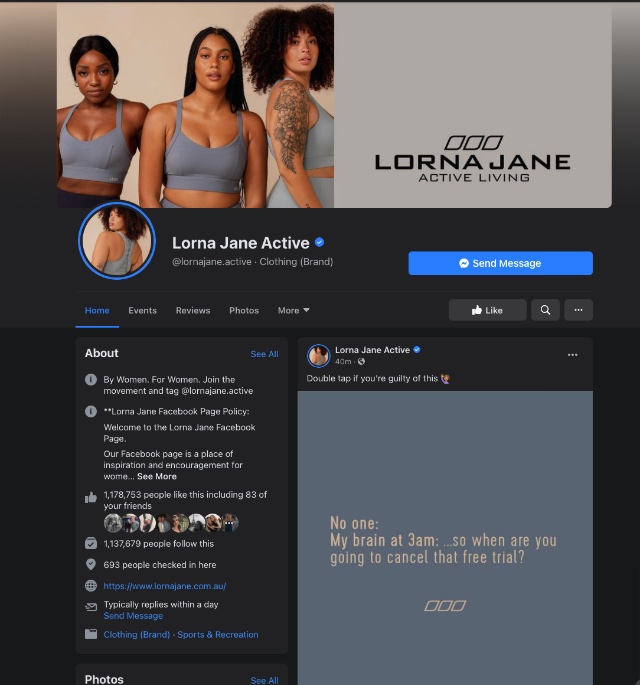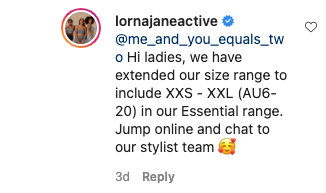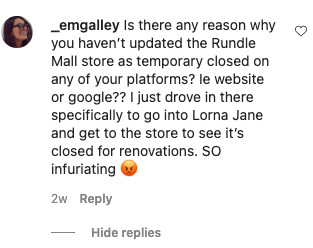Australian activewear brand Lorna Jane was founded in 1990 by Lorna Jane Clarkson and husband Bill Clarkson. Lorna was a part-time aerobics instructor at the time who was often dissatisfied with the workout gear available for her and her students, so started to make her own. The company now has stores around Australia as well as the US and stockists around the globe and is estimated to be with AUD $500 million.
Despite controversies along the way, Lorna Jane has become synonymous with the word activewear here in Australia. So how did they do it?
Well, the company’s digital strategy is a little different. They invest very little into advertising, and instead work on building a strong social media presence and sharing content that is interesting and useful for users. This is how the company really interacts and engages with customers.
Lorna Jane uses their Instagram as a platform to drive engagement and awareness. Screenshot.
ALL ABOUT THE SOCIALS, BABY
With a whopping 1 million followers, it’s clear that Instagram is the easiest way for Lorna Jane to connect with existing and potential customers. The feed is a well-curated and aesthetically pleasing mix of images of women in activewear, inspirational quotes, relatable memes, fitness/well-being advice and healthy recipes.
The thing with Lorna Jane is that much like Nike, they are not just selling activewear, they are selling an entire philosophy – ‘move, nourish, believe’. It’s a holistic approach to wellness and fitness that really comes across from the brand’s socials.
They’re also quite literally selling membership to a global community which engages in a number of events, including Active Nation Day and Fit Friday which are two of the most well-known of these global initiatives.
Lorna Jane uses Instagram stories as a valuable platform for content marketing.
Clearly, their target demographic is women and so the brand capitalised on the recent energy around the March4justice, and got active through Instagram stories, encouraging women to attend.
This push towards social engagement that remains aesthetically in-line with the brand’s feed as a whole is an extremely clever marketing strategy. The 1 million followers on Instagram are, for the most part, engaging with the brand because it’s sharing interesting, useful and pertinent content for their daily lives. The occasional sales pitch as new products are released is not viewed as overtly aggressive, then, and is instead more like a friend telling you about some cool new exercise tights she’s just found out about.
For more about why content marketing is so important and can be so great when done well, we’ve done a blog post on that before.
Selling a lifestyle and a philosophy rather than a product is not easy, clearly, but it’s a great ambition to have as your business seeks to capitalise on the ecommerce boom.
The other aspect of this philosophy that the brand really pushes on its socials is the sustainable aspect of the materials the clothing is made with. They also have an initiative that encourages customers to donate their old, unwanted exercise gear and receive Lorna Jane store credit in return.
One clear trend from 2020 was that consumers do not want companies to ignore sustainability, and Lorna Jane seems to be ahead of the trend on this one.
As well as Instagram, they run a relatively popular Facebook page with over a million likes, which drives a lot of engagement in the form of tags when they share memes.
Lorna Jane’s Facebook engages with customers by sharing ‘relatable content’ like memes.
THE BLOG
In line with this strategy of selling an entire movement or philosophy, Lorna Jane’s blog ‘Move, Nourish, Believe’ publishes a variety of content from recipes to workouts to tips on how to enjoy collagen.
This content is clearly very much in line with the brand’s philosophy, and because it is actionable and ever-green content, it can be re-shared as much as possible. Lorna Jane also sells various wellness products, including collagen powder, both in-store and online, and providing recipes that use such products is a great way to market without it seeming like marketing.
Traditionally, this would have been the kind of content they may provide in a book, so it’s key not to give away all of your tips and tricks online. Feed your customers enough to get them excited and ready to buy into this world.
This is a perfect example of actionable, high-quality content for SEO.
The brand also has a YouTube channel where workout and cooking videos are published alongside advertising material, however, engagement here is much lower than on Instagram.
TALKING TO CUSTOMERS
It’s easy to forget that behind the social media presence of brands like Lorna Jane are real employees who post, comment and respond to comments. One thing Lorna Jane is also a market-leader in is actually responding to comments on their posts. So, rather than moderating or deleting any negative feedback, they actually engage in a constructive discussion.
According to the brand, “the good and the bad of social media is that every customer has a voice. Ignoring that voice can be a fundamental mistake”.
Recently, along with many brands, Lorna Jane has come under fire for a perceived lack of diversity in their sizes.
Lorna Jane received a fair bit of negative feedback on the diversity of their sizes.
Comments such as the above, from user ‘me_and_you_equals_two’ are quite common across Lorna Jane’s Instagram page. The company was essentially ‘called-out’ for not having any sizes larger than a 16 – critics argued this is the average size in Australia for women, and so having this as the largest seemed to reinforce the stereotype that only slim women exercise, or should feel comfortable doing so.
In response to such concerns, despite previously publicly saying she would never extend the range beyond a size 16 as there was no market for it, Lorna Jane have since done so in their essentials range.
Lorna Jane received a fair bit of negative feedback on the diversity of their sizes.
You can see from the above response that the brand’s Instagram strategy is engagement, rather than burying negative comments. There are a few reasons such a strategy works well, but the main one is that it often stops upset customers from taking their tirades elsewhere. Instead, the problem is acknowledged and a potential fix is offered.
In the world of ecommerce, as in bricks-and-mortar retail, not every customer is ever going to be satisfied. In fact, problems are often exacerbated online as people are naturally more inclined to say things they would not say to a sales assistant when in-person.
Many brands could learn a lesson from Lorna Jane. Respond with a personalised message, an apology, a suggestion and, of course, an emoji.
Lorna Jane responds to negative feedback with a personalised message.
Lorna Jane responds to negative feedback with a personalised message.
Like many brands, Lorna Jane actively drives engagement with their socials by running competitions that require Instagram users to be following the brand, and to tag their friends – thereby consolidating and expanding the brand’s reach online.
Be wary of trying such tactics with Facebook, however, as they are very much against such strategies.
FAST 5
- Lorna Jane does not invest in much traditional advertising, using social media and word of mouth to expand their reach and influence.
- They are selling a philosophy and a ‘movement’ rather than just a product, so their Instagram feed reflects this with a mix of workout tips, recipes, memes and product placement.
- Their blog is a larger extension of this content, with full recipes and workout routines provided.
- The brand drives engagement by actively responding to feedback online, particularly when it’s negative.
- They run a lot of competitions which help to consolidate and expand reach.










